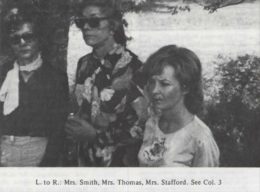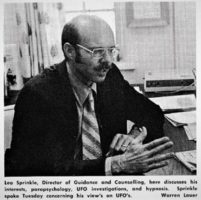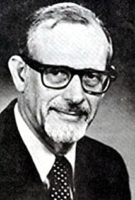By Charles Lear
 In last week’s blog, we looked at a UFO encounter in Kentucky reported by three women, Louise Smith, Mona Stafford, and Elaine Thomas. According to them, they saw a craft that shone a blue light into their car and seemingly took control of it. They felt pain down through the tops of their heads and in their eyes, felt the car being pulled backwards and then suddenly found themselves almost eight miles away in what seemed like an instant. The UFO was gone. They continued on to Liberty, Kentucky and stopped at the trailer home of Smith, who had been the driver. They became aware that they all had a number of physical ailments, including burning and tearing eyes, skin that burned when in contact with water and one-inch-by-three-inch marks on the backs of their necks. There was also about 80 minutes they couldn’t account for. Smith looked to see if any of her neighbors were awake and she saw a light on in the trailer next-door belonging to Lowell Lee. The women went over to his house and Lee listened to their story. He looked at the marks on their necks, and then had them go to separate areas and draw what they said they saw. The drawings were almost identical. The story found its way into the press and it wasn’t long before interested UFO investigators approached the women to look into the case.
In last week’s blog, we looked at a UFO encounter in Kentucky reported by three women, Louise Smith, Mona Stafford, and Elaine Thomas. According to them, they saw a craft that shone a blue light into their car and seemingly took control of it. They felt pain down through the tops of their heads and in their eyes, felt the car being pulled backwards and then suddenly found themselves almost eight miles away in what seemed like an instant. The UFO was gone. They continued on to Liberty, Kentucky and stopped at the trailer home of Smith, who had been the driver. They became aware that they all had a number of physical ailments, including burning and tearing eyes, skin that burned when in contact with water and one-inch-by-three-inch marks on the backs of their necks. There was also about 80 minutes they couldn’t account for. Smith looked to see if any of her neighbors were awake and she saw a light on in the trailer next-door belonging to Lowell Lee. The women went over to his house and Lee listened to their story. He looked at the marks on their necks, and then had them go to separate areas and draw what they said they saw. The drawings were almost identical. The story found its way into the press and it wasn’t long before interested UFO investigators approached the women to look into the case.
 According to the October 1976 APRO Bulletin, Jim and Coral Lorenzen of the Aerial Phenomena Research Organization were alerted to the case by APRO Field Investigator Bill Terry, who’d read an article on the reported encounter in the February 1, 1976 Kentucky Advocate. He wanted to know if they thought it was worth it for him to make the 60-mile trip to personally investigate, and they said yes. When he got to Smith’s home in Liberty, he found that investigators from the Mutual UFO Network and the Center for UFO Studies had gotten there the day before. Terry gathered information and then called APRO. He told the Lorenzens that he thought the women might have been abducted and that “the usual hypnosis procedures should be used.”
According to the October 1976 APRO Bulletin, Jim and Coral Lorenzen of the Aerial Phenomena Research Organization were alerted to the case by APRO Field Investigator Bill Terry, who’d read an article on the reported encounter in the February 1, 1976 Kentucky Advocate. He wanted to know if they thought it was worth it for him to make the 60-mile trip to personally investigate, and they said yes. When he got to Smith’s home in Liberty, he found that investigators from the Mutual UFO Network and the Center for UFO Studies had gotten there the day before. Terry gathered information and then called APRO. He told the Lorenzens that he thought the women might have been abducted and that “the usual hypnosis procedures should be used.”
 The Lorenzens contacted Dr. Leo Sprinkle, who was an APRO psychiatric consultant and experienced in hypnotic regression techniques. It was arranged that Sprinkle would travel to Liberty at APRO’s expense to interview the women and offer his services as a hypnotist. Sprinkle was an early abduction investigator and notably had regressed Nebraska police patrolman Herbert Shirmer in 1968. This was for the Air Force funded University of Colorado study headed by Dr. Edward Condon and is described in Case 42 in the results of the study published in 1968 as The Condon Report.
The Lorenzens contacted Dr. Leo Sprinkle, who was an APRO psychiatric consultant and experienced in hypnotic regression techniques. It was arranged that Sprinkle would travel to Liberty at APRO’s expense to interview the women and offer his services as a hypnotist. Sprinkle was an early abduction investigator and notably had regressed Nebraska police patrolman Herbert Shirmer in 1968. This was for the Air Force funded University of Colorado study headed by Dr. Edward Condon and is described in Case 42 in the results of the study published in 1968 as The Condon Report.
According to the Bulletin, Terry met Sprinkle and the two went to Smith’s home. When they got there, they “were met with a conglomeration of investigators from CUFOS and MUFON who felt they were ‘first’ on the case and that APRO should not be allowed to enter.” Sprinkle didn’t want to cause a scene and APRO was called.
The Lorenzens got in touch with Leonard Stringfield who was a member of all three organizations but was in Liberty investigating for MUFON. According to the Bulletin, Stringfield wanted to make use of Sprinkle but didn’t want a report sent to APRO. As one might expect, the Lorenzens didn’t take too kindly to the idea. Adding further to their indignance was the information from Smith that someone from either MUFON of CUFOS (she couldn’t remember which) had advised her and the other two women against co-operating with APRO because “they would call in the National Enquirer.”
It was eventually agreed that Sprinkle would hypnotize the women and that the case reports would only be published after “mutual agreement.”

Stringfield published his version of events in the January 1977 MUFON UFO Journal. According to him, Sprinkle arrived on March 5 and by March 7 an agreement was reached so that he could hypnotize Stafford, who was the only one of the three women to agree to the procedure. Under hypnosis, Stafford recalled details of the sighting but nothing that could help fill in the missing 80 minutes.
Sprinkle told Stringfield that Stafford was in a post-hypnotic state and that he might still be able to help her recall some more details. Stringfield then “edged” his chair closer to her, took a folder out of his briefcase with pictures of humanoids described by other witnesses, and “unceremoniously” placed it on a table next to her. She looked at the pictures and said that the head of one of the creatures “looks like the light I saw.” She then started to see a face in her mind’s eye that faded and re-appeared “like in a fog.”
It is mentioned in the Bulletin article that James C. Young, who gave the women polygraph tests at a later date, commented that he could not be sure how influential the interviews by the investigators previous to the tests had been on what the women believed they had experienced. It is pointed out in the article that MUFON investigators “apparently showed the witnesses drawings of UFOs and occupants before the witnesses made their own renderings of what they saw.” There is also the accusation in the article that “Mr. Stringfield” and “Mr. Black of MUFON” asked “some very suggestive and leading questions” during hypnosis sessions on July 24.
According to Stringfield, Sprinkle was unable to return after the March 7 session due to lack of funding. Then, Jerry Black of MUFON “announced” that he’d called Bob Pratt at the National Enquirer and “made a deal.” Part of the deal was that Sprinkle’s expenses would be paid for another trip to Liberty. The paper would also make arrangements James Young to administer polygraph examinations.
In spite of the Enquirer’s reputation for being less than a model of journalistic integrity, Pratt was a respected UFO investigator. According to Stringfield, “Black’s daring move, he averred, was out of concern for the women’s health. According to the CUFOS file generously provided by David Marler there was something to this. Smith had lost over 28 pounds, Stafford had lost 17, and all three women were experiencing fears and anxiety, with Stafford’s being the most severe.
The irony of Black reaching out to the Enquirer was not lost on the Lorenzens. It’s mentioned in the Bulletin as being a “surprise considering their (the women’s) reluctance to have anything to do with the paper if APRO was on the case.”
On June 23, the women, Pratt, Sprinkle, Stringfield, and Young all met at the Brown Motel in Liberty for the polygraph exams and the hypnosis sessions. By this time all three of the women were willing to undergo both the exam and the hypnosis. The polygraph exams were given first and because of the amount of time involved, there was only enough time the first night to hypnotize Smith. All three underwent hypnosis the next day.
Besides interviewing the witnesses, hypnotically regressing them, and giving them polygraph examinations, the investigators found additional witnesses and collected statements from character witnesses. While there was some sloppiness in terms of witness leading and petty rivalry, the investigators gathered some compelling evidence that something very strange had happened to Smith, Stafford, and Thomas.
Next week: THE EVIDENCE